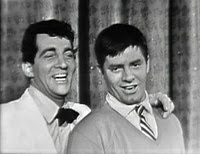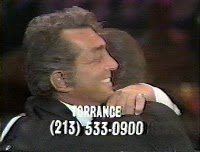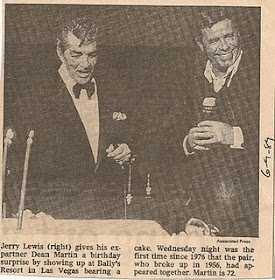As with his first two installments, this piece of Dino-prose is so full of Dino-pleasure....many wonderful insights into what finally split up the greatest comedy duo ever, with lots of media adds on....newpaper and tabloid clippin's, pixs of our Dino and the kid from television gigs, and more!
So loves how he ties the Dino-reunion that happened in '76 while the Jer was hostin' the MDA Labor Day Telethon. The pixs of our Dino and Jer embracin' and lovin' on each other is just so so heart-warmin' (to this Dino-holics thoughts...that few minutes of reunion is the bost important thin' ever broadcast on television...EVER!)
So, our Dino-deepest Dino-thanks for author Mr. Michael J. Hayde to sharin' this stellar Dino-literature with us. These Dino-series musta taken Mr. Hayde many, many hours to Dino-research and Dino-scribe....how wonderful to know there are those like Michael J. Hayde who helps others to know, love, and learn all we can 'bout the life and times of our beloved Dino. Dino-awed with Dino-gratefulness, DMP btw, pallies, as usual, just clicks on the tagg of this Dino-post to see this in it's glorious orginal Dino-format...and it woulda be so thoughtful of you if you woulda share your Dino-appreciato with Mr. Hyde for liftin' up the name of our Dino is such grand and glorious Dino-ways!
Wednesday, March 24, 2010
Martin vs. Lewis, T.K.O. (June-July 1956)

November 13, 1955: The day after Jerry Lewis unexpectedly played a benefit performance as a solo – one specially requested of the team by Paramount’s chief, Y. Frank Freeman (the man who’d rescued the pair from the ire of the IRS), and despite Dean Martin’s verbal assurances that he’d be there – Martin & Lewis made their final starring appearance on the Colgate Variety Hour. Again the pair trotted out a specialized tune meant to reassure viewers, this one based on “Two Lost Souls” from Damn Yankees:

Dean: It’s Jerry and Dean, and no one in between,
Jerry: Like let’s say Gallagher and let’s say Shean.
Dean: Of course we complain; we fuss and strain,
Jerry: But after the fussin’ there’s always us’n.
Dean: Ah, we’re two lost souls, each wedded to each,
Jerry: We go hand in hand, in all kinds of weather.
Dean: On the bottom or top,
Jerry: A hit or a flop,
Both: It’s both together.

But not for much longer. Eighteen months after Lewis had proclaimed “never in a million years” would the team split up, the only goal they shared was in desiring the swiftest, surest way to do just that.
The obstacles, however, were formidable. First, they owed producer Hal Wallis four more pictures, and after the Three-Ring Circus debacle, Wallis had a stipulation included in their contract: Martin and Lewis could only appear in films as a team, no matter who produced them. Second, the pair would net $4 million in 1955 (grosses were in the neighborhood of $20 million), and that kind of money was awfully hard to walk away from. Third, and most especially, neither man was 100% confident of his ability to go it alone.
Certainly Dean, if he’d put any stock into what critics had to say about his talents as an actor (“a competent straight man”) or singer (“he shouldn’t oughtta listen to any more Bing Crosby records”), would never have risked working outside the profitable confines of Martin & Lewis.
 But he’d just scored his second big smash, “Memories are Made of This,” which would sit comfortably at number one on the Hit Parade at the start of 1956. More importantly, he was being openly courted by two studios for solo roles: Warner Brothers offered him The Pajama Game with Doris Day, while MGM wanted him for an original story, Ten Thousand Bedrooms. With all this looming, the thought of cavorting alongside the human monkey was becoming unbearable.
But he’d just scored his second big smash, “Memories are Made of This,” which would sit comfortably at number one on the Hit Parade at the start of 1956. More importantly, he was being openly courted by two studios for solo roles: Warner Brothers offered him The Pajama Game with Doris Day, while MGM wanted him for an original story, Ten Thousand Bedrooms. With all this looming, the thought of cavorting alongside the human monkey was becoming unbearable.For his part, Jerry shrewdly recognized how important their personal relationship was to their success. Without that undercurrent of love and admiration supporting their antics, it was only a matter of time until, as he put it, “we’d get knocked through the ropes like Joe Louis.” Believing the relationship could be salvaged, Jerry conceived the idea of doing a contemporary take on the Damon and Pythias story: two men whose friendship is tested when one lays his life on the line for the other. To drive the point home, Dean would play Mike Damon, sympathetic policeman and Jerry would be
 Sidney Pythias, juvenile delinquent. This would be their next York picture, after finishing their current assignment for Wallis, Hollywood or Bust.
Sidney Pythias, juvenile delinquent. This would be their next York picture, after finishing their current assignment for Wallis, Hollywood or Bust.Unfortunately, Lewis assigned the writing of “Damon and Pythias” to his pal Don McGuire, the man who wrote Three-Ring Circus. McGuire’s opinion of Martin didn’t bode well for the project: “Dean was a terrible actor. He could barely talk. Jerry was the guy who made him a hit, made him funny.” Still, McGuire strove to create a story that gave both men “a close relationship;” meanwhile, Lewis campaigned with Freeman for the opportunity to direct the film.

If Jerry harbored any hope that the script would touch Dean’s heart and possibly rekindle their friendship, it was dashed almost as soon as Martin got hold of his copy. The next day, he let his partner know that he would in no way play a uniformed cop, claiming it was “low class.” Realizing that Martin didn’t read the script beyond his costume requirement, Lewis blew his stack: “Then we’ll have to get somebody else.” “Start looking, boy,” Martin retorted and stormed off.
Not too long after this, the pair reported to work on Hollywood or Bust, only speaking to each other when cameras rolled. For the first few weeks, Lewis sabotaged the production, intentionally blowing lines and breaking character; partly to retaliate against Martin, but mostly with the intent to force Hal Wallis to renegotiate – or release them from – his restrictive contract.
 The gambit failed; director Frank Tashlin, no doubt with Wallis’ blessing, simply threw Lewis off the picture, forcing the comic’s hand.
The gambit failed; director Frank Tashlin, no doubt with Wallis’ blessing, simply threw Lewis off the picture, forcing the comic’s hand.Chastened, Lewis returned to Hollywood or Bust and, in his words, “tried for the miracle.” “You know, it’s a hell of a thing,” he suddenly said to Martin during a break. “All I can think of is that what we do is not very important. Any two guys could have done it. But even the best of them wouldn’t have had what made us as big as we are.”

“Yeah? What’s that?”
“Well, I think it’s the love that we had – that we still have – for each other.”
Martin thought long and hard about what he had to say, then said it. “You can talk about love all you want. To me, you’re nothin’ but a (bleep)in’ dollar sign.”
And that was it. Both men knew: it was over. Jerry went straight to Y. Frank Freeman for permission to make “Damon and Pythias” (which would eventually be titled The Delicate Delinquent) with another costar. The news broke on June 18.

Still, Dean and Jerry faced a month of confirmed personal appearances, which they met through sheer force of will. There were some rough patches, one of them being a Today Show appearance on June 26 (“Dean and I [could] hardly bear to look at each other,” remembered Lewis fifty years later; the kinescope bears him out). Serendipitously, their nightclub

engagements were due to conclude on July 24 – exactly one day shy of ten years since their official teaming at Atlantic City’s 500 Club.

Those with a vested interest in maintaining the status quo of Dean and Jerry Incorporated – Hal Wallis, NBC – were forcibly persuaded to renegotiate contracts. At the insistence of Freeman, Wallis permitted them one solo film each. Not until 1957 did he agree to let them meet the balance of their contract individually, thus getting six pictures for the price of three. NBC considered suing to keep the pair together, then discovered to their chagrin that their five-year deal was contractually with York Productions, with no stipulation that the company deliver Martin and Lewis as a team. The following year, Dean negotiated his own NBC deal and sold his share of York to Jerry, who in turn sold the company and their piece of the York films to Paramount.
Over the years, each man would take credit for initiating the split, which was in essence the truth: Dean’s refusal to do The Delicate Delinquent would spark Jerry’s behind-the-scenes machinations to get them released from Wallis’ iron grip. Each man reached his individual goals: Dean became “a real actor” in such fine films as The Young Lions, Some Came Running and Rio Bravo, while Jerry made so much money for Paramount that owner Barney Balaban famously said, “If he wants to burn down the studio, I’ll hand him the match.”


But it was live television that made Martin & Lewis superstars, so it was entirely fitting that their estrangement came to an end on live TV; in September 1976 during Lewis’ annual telethon for Muscular Dystrophy. The reunion, like the split, made headlines, and raised hopes that Dean and Jerry would again entertain together. It was not to be; Martin and Lewis would publicly reunite only once more, briefly on a Las Vegas stage in 1989 for Dean’s 72nd birthday. By then, life’s ebb and flow had washed away the pain and bitterness for both men, to where Dean could publicly assure Jerry, “I love you and I mean it.” Martin retired in 1991 and died four years later; Lewis continues to do what he loves: make others laugh, cry and cheer.

More than a half-century after their parting, how to sum up the appeal of Dean Martin & Jerry Lewis? Perhaps we should let them do it. Jerry: “Two guys who had more fun than the audience.” Dean: “With Jerry and me, it was mostly just doin’ what we felt. Those were great times.” Indeed they were.

No comments:
Post a Comment